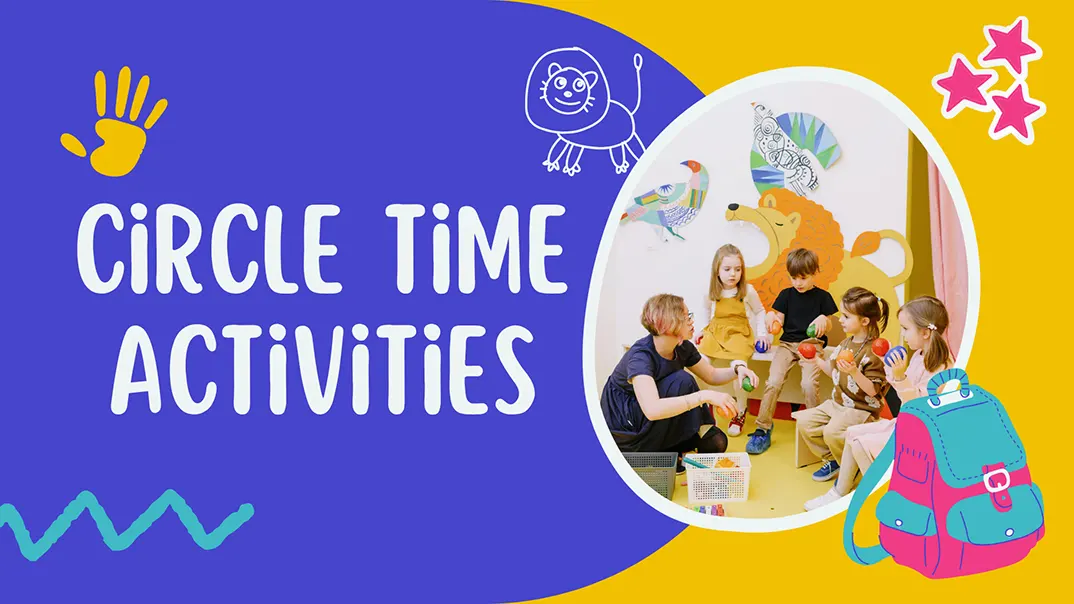Are your students losing focus during morning routines? Do you often wonder how to make group time more meaningful, interactive, and developmentally appropriate? Many early childhood educators struggle with creating consistent, engaging circle time activities that truly capture children’s attention and support their learning goals. Without structure and purpose, circle time can quickly become chaotic or ineffective—wasting valuable teaching moments.
Circle time activities are short, intentional group routines designed to foster communication, community, and foundational learning in early childhood classrooms. These activities may include songs, stories, discussions, games, and movement exercises that promote social, emotional, language, and cognitive development. When used consistently and creatively, circle time becomes more than just a daily ritual—it becomes a powerful tool for classroom management and child-centered learning.
Ready to transform your classroom routine and captivate young minds with meaningful moments? In the sections ahead, we’ll explore 30 highly engaging circle time activities that are easy to implement and developmentally enriching.
What is Circle Time?
Circle time is a structured group activity commonly used in early childhood classrooms to foster social interaction, build a sense of community, and introduce key learning concepts. Typically held at the beginning or end of the day, it involves children gathering together—often in a circle—to engage in shared experiences such as songs, stories, discussions, games, or calendar routines.
The goal of circle time is not just to deliver content but to create meaningful connections among children and between the teacher and the group. Through well-planned circle time activities, educators can help children develop important skills such as listening, taking turns, following directions, expressing ideas, and working cooperatively. It also sets the tone for the day, helping children feel safe, welcomed, and ready to learn.
While circle time can vary in length and content depending on the age group, classroom style, and learning goals, its central function remains the same: to bring the class together in a shared, intentional space that promotes both personal and academic growth. When implemented thoughtfully, circle time becomes a cornerstone of early childhood learning.
Why is Preschool Circle Time Important?
Preschool circle time is far more than a daily classroom routine—it’s a critical foundation for early childhood learning and development. Through consistent and intentional circle time activities, children begin to understand how to function as part of a group, listen actively, take turns, and engage in cooperative behavior. These early social experiences play a key role in preparing children for future academic success and interpersonal relationships.
1. Sense of Community
One of the most important aspects of circle time is its ability to foster a sense of community. When children gather together in a circle, they experience a shared space where every voice matters. This inclusive environment helps build trust, emotional security, and a classroom culture where children feel seen and heard. As a result, children are more likely to participate confidently in other classroom activities.
2. Social and Emotional Skills
Circle time activities encourage children to practice important social behaviors such as sharing, waiting patiently, and empathizing with peers. Over time, these group experiences support emotional regulation, self-awareness, and respectful communication—skills that are essential in both academic and real-life settings.
3. Cognitive and Language Development
Circle time provides daily opportunities for children to expand vocabulary, improve listening comprehension, and engage in meaningful conversations. Whether it’s singing songs, answering questions, or discussing the calendar, these structured routines promote language fluency and early 識字能力の発達.
4. Predictability and Classroom Routine
A consistent circle time routine helps children feel secure and understand what to expect each day. Predictability reduces anxiety, improves classroom behavior, and allows children to transition smoothly between activities. This structure lays the groundwork for independent learning and self-regulation.
5. School Readiness
Circle time activities play a vital role in preparing children for the structure and expectations of formal schooling. Through regular participation, children learn how to follow group instructions, sit for extended periods, raise their hands to speak, and transition smoothly between tasks—core elements of school readiness. By weaving academic, social, and behavioral expectations into a familiar and nurturing setting, circle time sets the stage for long-term success in school environments.
30 Engaging Circle Time Activities and Games
Circle time is one of the most important parts of a preschooler’s day. It provides a structured yet playful setting where children come together to build community, strengthen routines, and develop essential social, emotional, and cognitive skills. Below are 30 engaging and developmentally appropriate circle time activities that you can easily incorporate into your early childhood classroom.
1. Story Retell with Props

Using simple story props to retell a familiar story enhances language comprehension and narrative skills. In this circle time activity, children use puppets, pictures, or felt characters to take part in retelling a story as a group. This encourages active listening and memory recall in a fun, interactive setting. Each child participates in moving the story forward using a prop or gesture.
必要な材料
- A familiar children’s story (e.g., “The Very Hungry Caterpillar”)
- Related props such as puppets, felt board characters, or picture cards
Step‑by‑Step Instructions
- Read or summarize the familiar story in the circle to refresh your memory.
- Distribute props or assign gestures to each child for story characters or events.
- Invite children one at a time to stand up and use their prop while retelling their part.
- Guide the sequence by prompting the next child to continue the narrative.
- Wrap up by retelling the whole story once more, with everyone joining in.
Learning Objectives
This activity enhances oral language skills by encouraging children to use their own words when interacting with props. Story retelling strengthens comprehension, sequencing, and memory. Group narration fosters collaboration, patience, and respectful listening. It also supports vocabulary development and confidence—the kind of holistic learning circle time activities aim to provide.
2. Good Morning Song
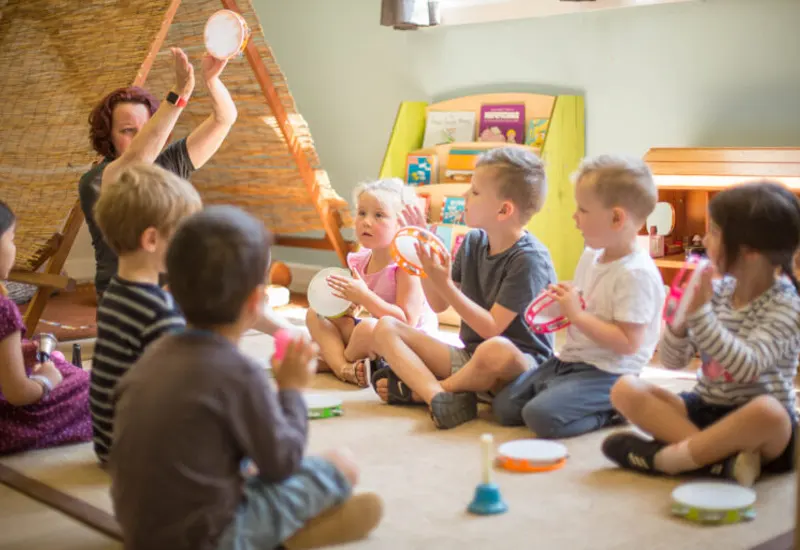
The “Good Morning Song” is a warm and inviting way to begin circle time activities each day. This activity welcomes every child and helps establish a consistent morning routine. Singing together creates a sense of cohesion and eases transitions into the learning environment. Over multiple days, children begin to anticipate the song, recognize lyrics, and feel part of a caring classroom community.
必要な材料
- A simple “Good Morning” song audio or lyrics poster
- Optional: a rhythm instrument like a small hand drum or shaker
Step‑by‑Step Instructions
- Start the circle and introduce the “Good Morning Song” with music or a poster.
- Sing the song as a group, encouraging children to join in on familiar lines.
- Use a rhythm instrument for children to play along during parts of the song.
- Invite volunteers to lead a verse or play the rhythm instrument.
- End by greeting each child by name after the song finishes.
Learning Objectives
This activity builds a joyful classroom atmosphere, reinforcing positive social and emotional development. Children learn to participate in group singing, fostering musical awareness and memory recall. Greeting classmates by name enhances name recognition and interpersonal connection. It also reinforces routine and structure, an essential part of all effective circle time activities.
3. Count and Clap
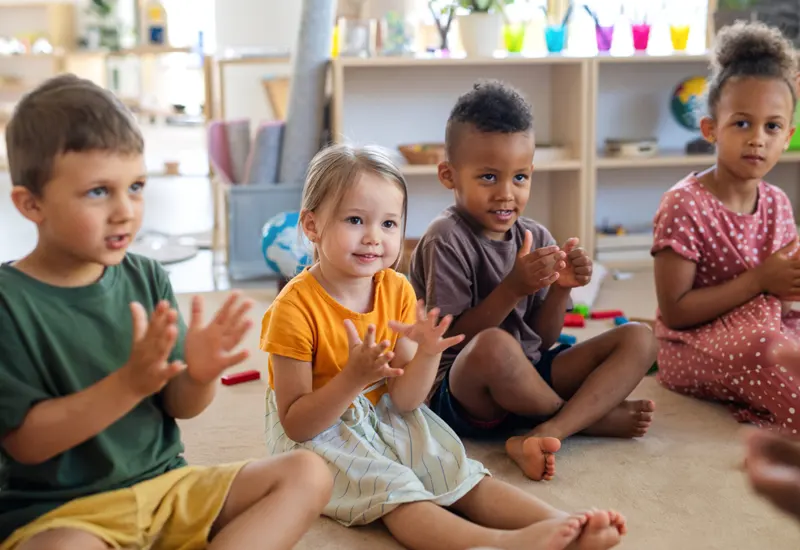
“Count and Clap” is a hands‑on counting activity that combines movement and numeracy skills. In this circle time activity, children count rhythmically while clapping to reinforce one‑to‑one correspondence. It supports early math learning and encourages gross motor coordination. By clapping together, children also practice group timing and auditory attention.
必要な材料
- Number cards or visual aids displaying numbers 1–10
- Optional: drum or clapping sticks
Step‑by‑Step Instructions
- Display number cards in the circle where all children can see.
- Call out a number and demonstrate clapping that many times.
- Children count aloud and clap along together at the correct rhythm.
- Increase the challenge by asking for higher numbers or letting children choose the number.
- Invite a child volunteer to lead the count and clapping for the group.
Learning Objectives
Children develop early math skills through counting practice as they count and clap. The activity supports number recognition and one‑to‑one correspondence. Clapping reinforces motor coordination, rhythm awareness, and timing. Participating in a group counting activity promotes listening, turn-taking, and attention during circle time activities.
4. Emotion Check–In
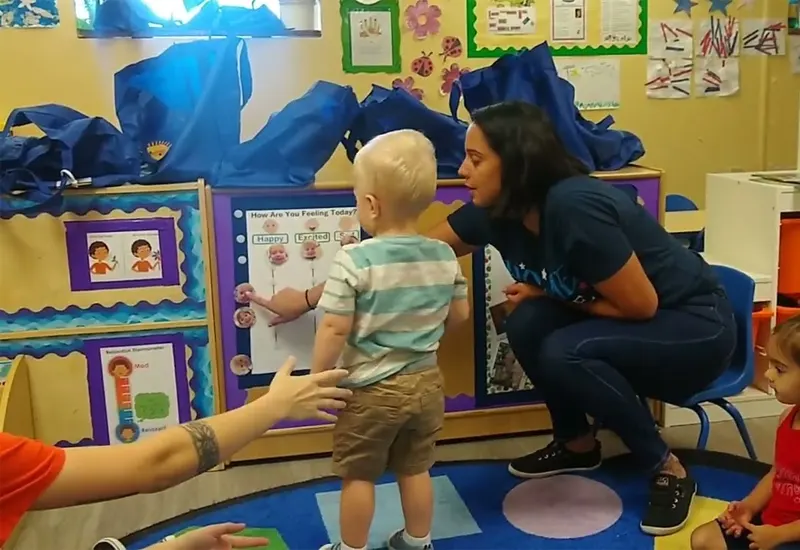
Emotion Check‑In is a reflective activity designed to help young children recognize and articulate their feelings at the start of circle time activities. Children choose from simple emotion visuals or cards (like happy, sad, excited) and share why they feel that way. This process builds emotional literacy and a supportive classroom climate.
必要な材料
- Emotion chart or cards with faces and labels (happy, sad, surprised, calm, etc.)
- A visual pointer or spinner to assist selection
Step‑by‑Step Instructions
- Present the emotion chart and briefly model identifying how you feel.
- Invite each child to select an emotion card that matches their mood that day.
- Ask the child to explain (in a few words) why they chose that emotion.
- Validate their sharing, and model empathic responses.
- Conclude by acknowledging the range of emotions around the circle.
Learning Objectives
This activity supports emotional awareness by helping children name and express their feelings authentically. Children develop vocabulary associated with emotions and practice articulating personal experiences. Participation fosters empathy and social understanding among peers. It also reinforces a sense of belonging and emotional safety that sets a positive tone for all circle time activities.
5. What’s the Weather Like Today

This daily weather routine provides a meaningful way to connect children with the natural world. It encourages children to observe their environment and make simple reports about what they see. The weather routine also gives structure to the morning and creates a predictable rhythm that children can anticipate. Over time, it helps build an early understanding of climate patterns and seasonal changes
必要な材料
- Weather chart or cards (sunny, cloudy, rainy, etc.)
- Window with outdoor visibility
- Weather pointer or stick (optional)
Step‑by‑Step Instructions
- Invite a child to look out the window and describe the weather.
- Ask them to choose the matching weather card and place it on the board.
- Prompt a short discussion about how the weather feels or what it means for playtime.
- Conclude with a weather song or chant to reinforce vocabulary.
Learning Objectives:
This activity encourages observation and communication by inviting children to describe what they see using appropriate weather-related vocabulary. It nurtures early science thinking by helping them notice and classify different weather types. In group discussions, children also practice listening and turn-taking, which are critical social skills. Overall, the routine contributes to their sense of time, daily rhythm, and connection to the world around them.
6. Movement Freeze Game

The Movement Freeze Game adds dynamic physical energy to circle time activities while still reinforcing attention and self-control. Children dance or move to a tune, and when the music stops, they freeze in place. This playful break fosters motor skills, listening, and impulse control. It’s especially effective to re-energize children between quieter circle segments or transitions in the preschool schedule.
必要な材料
- A music player with upbeat songs suitable for preschool
- Enough open space for movement inside or outside the circle
Step‑by‑Step Instructions
- Play the music and encourage children to move, dance, or sway within the circle.
- After a few moments, pause the music and prompt “Freeze!”
- Children must stop all movement immediately and hold their pose.
- Resume music and repeat several rounds, varying speed or style.
- Conclude with a group stretch or breathing activity to settle before the next segment.
Learning Objectives
This activity develops gross motor skills through coordinated movement and rhythmic response. Children practice listening skills by stopping as soon as the music stops, reinforcing impulse control. The playful energy supports attention regulation and classroom dynamics. When used within circle time activities, it provides a balanced mix of active and calm moments, keeping children engaged and focused.
7. Show and Tell
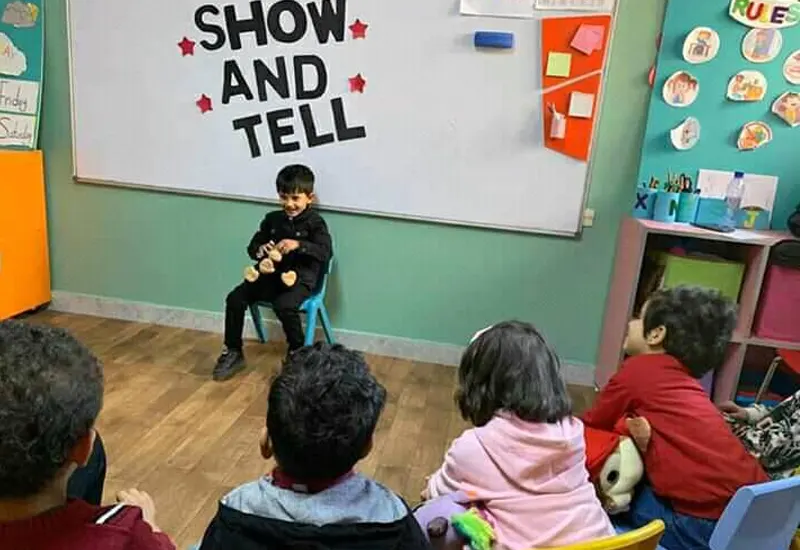
“Show and Tell” encourages children to bring in a personal item and share its story with peers. Sharing meaningful objects helps classmates develop listening skills and fosters empathy by learning about others’ interests and experiences. Including this activity regularly as part of circle time activities builds a sense of community and belonging in the preschool classroom.
必要な材料
- A personal item brought by a child (e.g. favorite toy, photo, or small object)
- Simple presentation spot marked in the circle
Step-by-Step Instructions
- Invite one child at a time to present their item to the group.
- The presenter holds up the item and tells one or two sentences about it.
- After the sharing, the teacher or peers ask a simple question to prompt dialogue.
- Move on to the next child, repeating the process until all presenters have shared.
- Thank each child for sharing and reinforce positive listening behavior at the end.
Learning Objectives
This activity builds expressive language skills by supporting narrative and descriptive vocabulary. Listening peers learn to pay attention, ask questions, and show respectful engagement. Presenting an item enhances self-confidence and public speaking readiness. Through regular circle time activities, it also deepens classroom connection as children explore each other’s perspectives and interests.
8. Mystery Bag Guessing Game
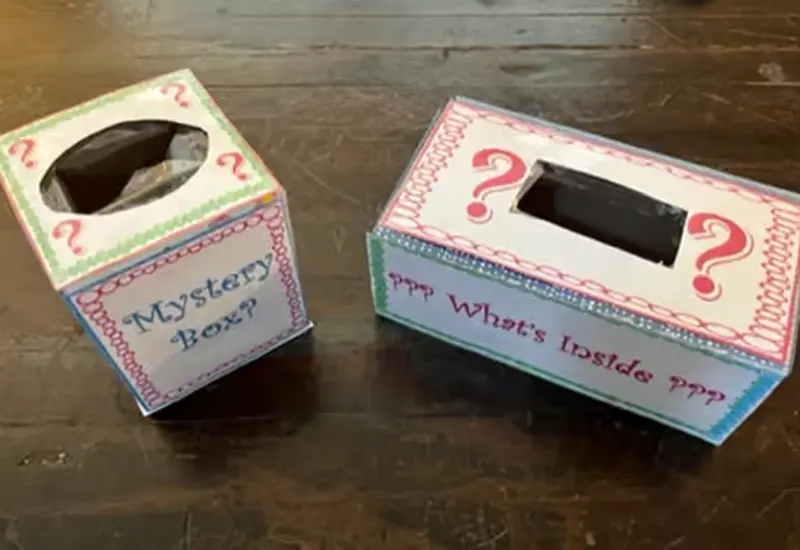
This circle time activity engages children’s senses and vocabulary skills through a tactile guessing game. A small bag is filled with familiar classroom objects, and children take turns feeling one object inside the bag without looking. They then try to guess what it is based on touch alone. The game builds curiosity, descriptive language, and early inferencing skills in a fun and social way.
必要な材料
- A small cloth or opaque bag
- 5–6 familiar classroom objects (e.g., toy block, spoon, feather, crayon, small ball)
Step-by-Step Instructions
- Gather children in a circle and show them the mystery bag.
- Explain that inside are objects they may know, but they can’t look—only feel.
- Choose a child to go first, and let them reach into the bag and feel one object.
- Ask them to describe what they feel (“It’s round and smooth…”) and guess what it is.
- Reveal the object, then move to the next child.
- Continue until each child has had a turn.
Learning Objectives:
This activity enhances descriptive language and builds vocabulary as children learn to articulate texture, shape, and size using sensory input. It strengthens critical thinking and early problem-solving by encouraging children to make inferences from limited information. Socially, it supports listening, turn-taking, and patience. The excitement and novelty of the mystery bag also make it an excellent engagement tool, especially for quieter or reluctant participants.
9. Color of the Day Discussion
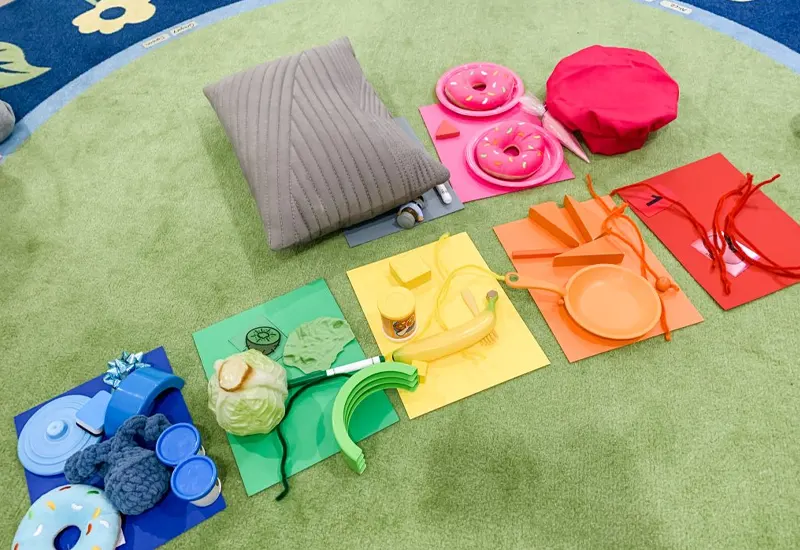
In this circle time activity, a “Color of the Day” is introduced for children to explore and discuss together. It begins with naming and identifying the color, followed by group sharing: who’s wearing the color, where we see it in nature, or what objects match it. This simple, open-ended conversation helps expand vocabulary, observational skills, and social communication in a playful way.
必要な材料
- Color cards or swatches
- Optional: small basket with objects of that color
Step-by-Step Instructions
- Choose or display the “Color of the Day” using a visual card.
- Say the name of the color clearly and invite children to repeat it.
- Ask: “Who is wearing this color today?” and go around the circle.
- Discuss where the color appears in real life (e.g., “Where do we see blue outside?”).
- Optional: Pass around a basket of color-matching items for observation.
Learning Objectives:
This activity promotes language development by encouraging descriptive talk and real-life associations. It enhances attention to detail and helps children categorize and make connections between objects and colors. Socially, it builds group cohesion through sharing and turn-taking. Repeated over time, it also strengthens color recognition and early classification skills, key components of pre-math and pre-literacy development.
10. Animal Sounds & Movements
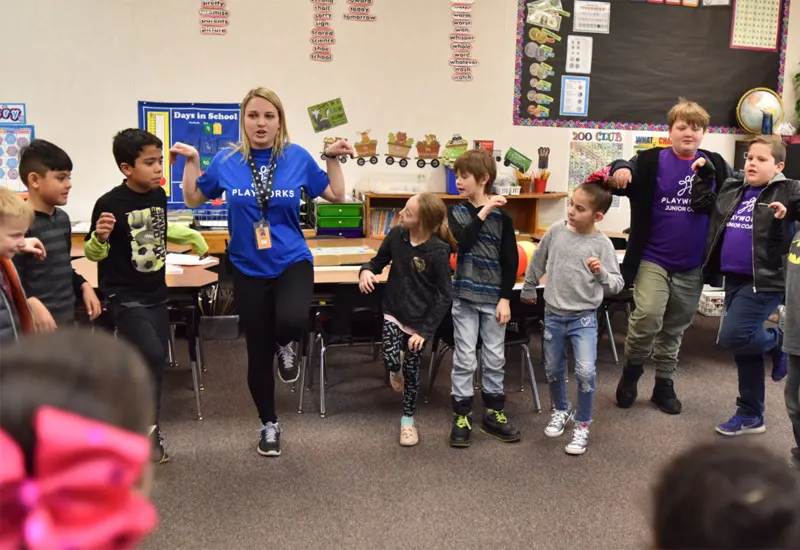
During this circle time activity, children imitate animal behaviors while others guess which animal they are. It builds vocabulary, gross motor skills, and listening. This multi-sensory experience also encourages creativity, humor, and peer connection. Incorporating movement and imagination keeps children energized and engaged in group learning.
必要な材料
- Picture cards of familiar animals
- Optional: plush toys or animal masks
Step‑by‑Step Instructions
- Show an animal card or mask and model the sound/movement.
- Invite a volunteer to mimic the animal for the class.
- Other children guess which animal it is.
- Rotate turns until several children have participated.
- Discuss animal characteristics or habitats briefly.
Learning Objectives
Children develop expressive vocabulary by naming animals and sounds. They refine gross motor coordination through imitation. Listening and guessing about peers’ performances boosts auditory discrimination and focus. As part of circle time activities, this game fosters participation, creativity, and group fun.
11. Mindful Breathing Routine
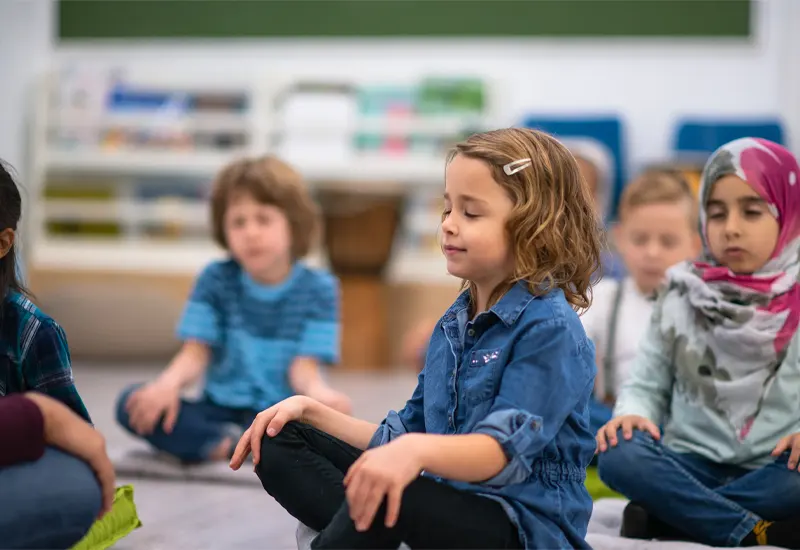
Mindful Breathing Routine introduces simple calming techniques to support emotional regulation and focus. This mini mindfulness break gives children a moment to slow down and center themselves. Breath counting, blowing pretend bubbles, or using stretching motions help develop body awareness. Over time, children learn how to self-regulate emotions and settle their energy before moving on to learning tasks.
必要な材料
- Optional: glitter jar, bubble wand, or soft music
- Comfortable sitting space in the circle
Step‑by‑Step Instructions
- Instruct children to place their hands on their bellies and take a deep inhale.
- Model slow exhale and invite children to copy.
- Optionally, blow “pretend bubbles” with hand motions or a wand.
- Count breaths aloud (“Inhale… Exhale…”) for a few rounds.
- Finish by noticing how their bodies feel and transitioning slowly.
Learning Objectives
This activity supports self-awareness and emotional regulation. Children learn to notice and calm their breath and body. Practicing mindfulness improves attention and reduces anxiety or restlessness. Including this within circle time activities helps children begin the day with calm focus and prepares them for learning tasks.
12. Don’t Wake the Monkey

Don’t Wake the Monkey is a quiet circle game that teaches young children self-control, focus, and gentle behavior. At the center of the circle lies a plush monkey, “sleeping” soundly. Children take turns attempting quiet challenges—like placing an object next to the monkey or sneaking up with soft footsteps—without “waking” it.
必要な材料
- A stuffed monkey or toy (to act as the “sleeping monkey”)
- A sound-producing object (e.g., small bell, keyring, shaky container, or jingly toy)
Step‑by‑Step Instructions
- Place the monkey toy in the center of the circle and tell the children the monkey is asleep and very sensitive to noise.
- Show the group the sound-producing object and explain that it must be passed slowly and carefully without making it jingle.
- Choose one child to start and pass the object to the person next to them, using two hands and as little noise as possible.
- If a sound is made, pause and whisper dramatically, “Shhh… you almost woke the monkey!” and then continue.
- Challenge the group to pass the object all the way around the circle without a single jingle. Try again to beat the previous record.
Learning Objectives:
This activity strengthens impulse control, attention, and body awareness, as children must move slowly and deliberately to avoid making noise. It encourages mindfulness and emotional regulation, helping children shift from high-energy states into calm focus. Socially, it builds cooperation and shared responsibility, as each child’s movement impacts the group’s success. The imaginative framing keeps children engaged, making self-discipline feel like a playful mission rather than a rule.
13. Pass the Rhythm
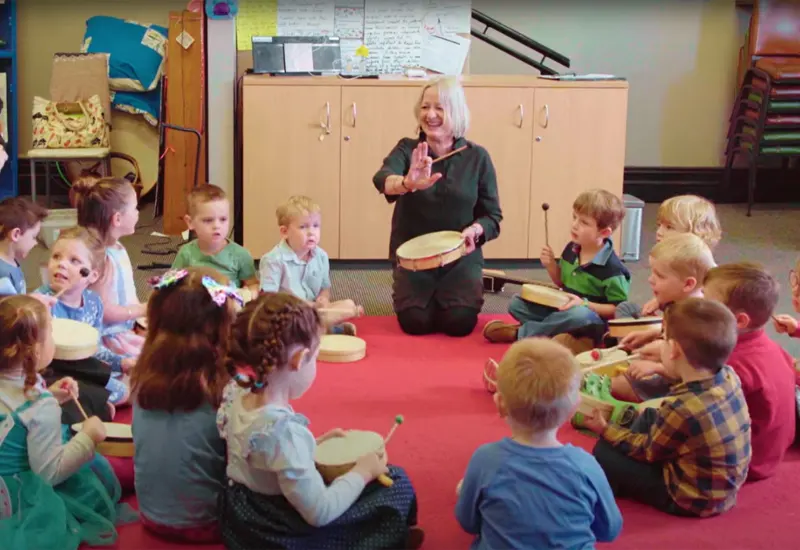
“Pass the Rhythm” is a fun and focused listening game that builds auditory memory, concentration, and coordination. The teacher begins by clapping or tapping a short rhythm pattern, which is then passed around the circle as each child tries to repeat it accurately to the next person. The rhythm can vary in difficulty depending on age level and group energy.
必要な材料
- Hands for clapping or table/floor for tapping
- Optional: rhythm sticks, small drums, or shakers (one per child)
Step‑by‑Step Instructions
- Have children sit in a circle and explain that they will be passing a rhythm around—just like a secret message, but with sound.
- Start with a simple 2–3 beat rhythm (e.g., clap–clap–pause or tap–tap–tap).
- Perform the rhythm for the first child, then ask them to repeat it and pass it to the next person.
- The rhythm continues around the circle. If someone forgets or changes it, gently reset and try again.
- Increase difficulty gradually by adding beats or introducing instruments.
Learning Objectives:
This activity supports auditory sequencing and memory by encouraging children to focus closely on rhythm patterns and reproduce them. It builds foundational music skills such as beat recognition, tempo, and repetition, which are essential precursors to musical literacy. The game also reinforces turn-taking, listening, and collaborative participation, helping children become more attuned to group dynamics. As the rhythms evolve, children gain confidence in expressive movement and nonverbal communication.
14. Mirror Me
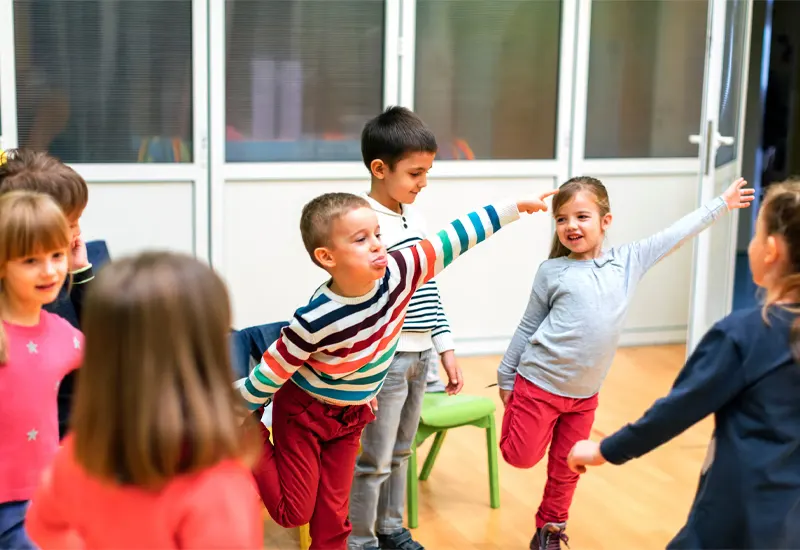
“Mirror Me” is a nonverbal movement game that encourages focus, body awareness, and social connection. In this activity, one child becomes the “leader” and performs slow, simple movements while the rest of the group tries to mirror them as closely as possible. It’s an excellent tool for calming transitions, building observation skills, and reinforcing the concept of following directions.
必要な材料
- None
Step‑by‑Step Instructions
- Ask all children to stand or sit facing a partner or in a semicircle facing the teacher.
- Begin as the first leader, performing slow, easy movements (e.g., raising arms, turning head, tapping shoulders).
- Children mirror the movements exactly and silently.
- Invite individual children to take a turn being the leader while the rest follow.
- Rotate leaders every 30–60 seconds, keeping the pace gentle and focused.
Learning Objectives:
This activity builds nonverbal communication skills and sharpens visual attention, as children must closely observe and match movement in real time. It supports self-regulation by encouraging slow, deliberate motion and reinforces the concept of leading and following respectfully. The mirroring format also promotes empathy and connection as children experience both roles. Additionally, it serves as a calming, body-based transition between high-energy activities and focused learning.
15. Sound Detective

In “Sound Detective,” children sharpen their listening skills by identifying mystery sounds created with common classroom objects. Each sound is made out of sight—behind a screen, under a cloth, or from a hidden box—and children must guess what they hear. This simple activity promotes focused attention, early phonemic awareness, and vocabulary expansion through sensory curiosity and group discussion.
必要な材料
- A variety of sound-making items (e.g., keys, crinkled paper, zipper, blocks, plastic bottle, bell)
- A cloth or box to hide the object while making the sound
Step‑by‑Step Instructions
- Seat children in a circle and explain that today they are “sound detectives.”
- Hide behind a box or cloth and make a mysterious sound with one of the objects.
- Ask children to raise their hands to guess what they think made the sound.
- Reveal the object and allow them to hear it again in plain sight.
- Repeat with different objects, or invite children to try creating the mystery sound.
Learning Objectives:
This activity strengthens auditory discrimination and descriptive language as children listen for fine differences in pitch, rhythm, and texture. It builds critical thinking and reasoning as they connect sounds to real-world objects. Socially, it encourages listening to others and practicing respectful turn-taking. As a bonus, it’s a quiet but deeply engaging game that helps children center their attention and transition into focused learning periods.
16. Would You Rather
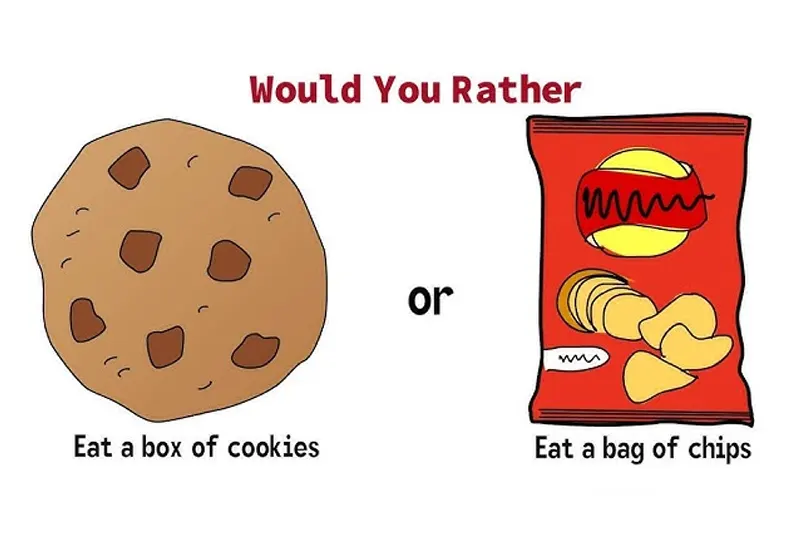
“Would You Rather” is a verbal choice-based game that encourages children to express preferences, explain simple reasoning, and respect different opinions. It requires no physical materials, only creative questions such as “Would you rather have a pet dinosaur or a robot?” Children listen, choose sides, and optionally explain their choices, which builds speaking confidence and social awareness.
必要な材料
- A prepared list of simple, age-appropriate “Would You Rather” questions
- Open circle seating to promote face-to-face interaction
Step‑by‑Step Instructions
- Pose a “Would You Rather” question to the group.
- Ask children to raise their hands for one choice or the other.
- Invite one or two volunteers to explain why they picked their choice.
- Celebrate different perspectives and gently encourage quieter children to speak.
- Continue with a new question each round.
Learning Objectives
This activity develops decision-making and expressive language skills. Children learn to articulate thoughts and accept differing viewpoints. Listening to peers builds empathy and conversation etiquette. As part of circle time activities, this type of discussion strengthens group dialogue, perspective-taking, and verbal confidence.
17. What’s Missing?

“What’s Missing?” is a visual memory game designed to sharpen observation, focus, and recall skills. The teacher places several familiar objects in the center of the circle, allows the group to study them, and then secretly removes one. Children guess which item disappeared. This activity engages visual attention and boosts short-term memory in a fun, hands-on format ideal for circle time activities.
必要な材料
- 5–7 small familiar classroom items (e.g., crayon, spoon, leaf, toy car)
- A cloth or scarf to cover objects
Step‑by‑Step Instructions
- Place the items in the center and let children observe for about 30 seconds.
- Cover the items, remove one secretly, and re-cover.
- Uncover the set and ask, “What’s missing?”
- Let children guess and explain their thinking.
- Rotate items and repeat for multiple rounds.
Learning Objectives
This activity improves attention to detail and memory recall. Children learn to scan, compare, and communicate visual information. Group guessing builds participation and teamwork. As a cognitive-based circle time activity, it supports foundational skills for learning, such as noticing patterns and remembering changes.
18. Silent Line-Up Challenge
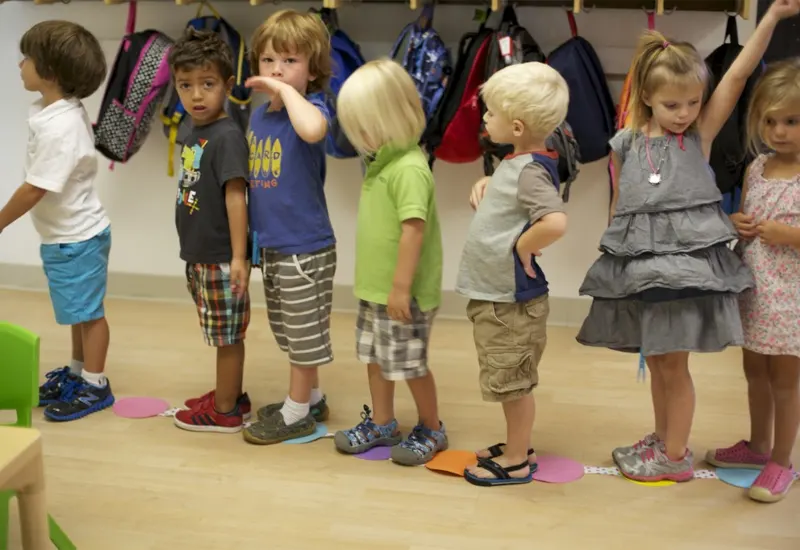
Silent Line-Up Challenge is a cooperative, non-verbal activity that sharpens group problem-solving and communication without speaking. Children are asked to line up in order—by height, birthday month, or shoe color—without talking. It builds teamwork, observation skills, and self-control. Children must rely on gestures, pointing, and mutual awareness to succeed as a team.
必要な材料
- A prepared category for organizing (e.g., birthday months, heights)
- A clear floor space for lining up safely
Step‑by‑Step Instructions
- Introduce the challenge rules: “No talking. Work together using gestures.”
- Choose a category: e.g., “Line up from shortest to tallest.”
- Allow time for the group to organize themselves silently.
- After lining up, check and celebrate success or gently correct.
- Rotate with different criteria and roles in each round.
Learning Objectives
This activity supports non-verbal communication, observation, and group coordination. Children develop patience, focus, and the ability to read social cues. It encourages self-awareness (e.g., “Where do I fit in?”) while reinforcing a sense of team achievement. Within circle time activities, it cultivates peer collaboration and emotional self-regulation in a light, engaging way.
19. I Spy Colors
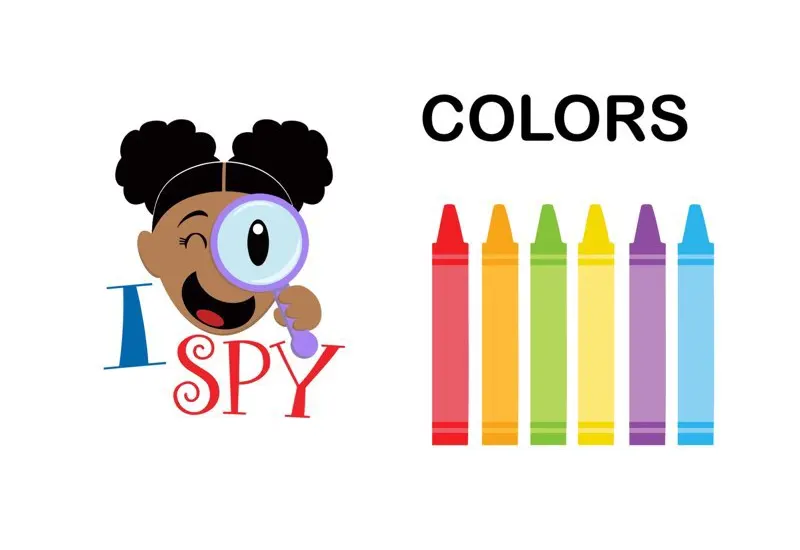
“I Spy Colors” is a classic observational game adapted for circle time, helping young children practice color identification and environmental awareness. In this version, the teacher or a student gives clues using the sentence frame “I spy something that is [color],” and the group looks around the room to guess what it might be. The game promotes language, visual scanning, and social participation in a relaxed.
必要な材料
- None
Step‑by‑Step Instructions
- Sit with the group in a circle and explain that you’ll be playing a color guessing game.
- Say, “I spy something that is red,” and allow children to look around and guess.
- Offer hints if needed, and confirm the correct answer when it’s found.
- Invite children to take turns being the “spy” and choosing a color for others to guess.
- Repeat as long as interest holds or transition into a related color activity.
Learning Objectives:
This activity helps children build vocabulary and descriptive language through real-world color identification. It encourages visual attention and environmental awareness as children search for specific features in the room. Socially, it supports turn-taking, communication, and cooperative guessing. The open-ended nature makes it easy to adapt to any theme or skill level, offering flexibility for teachers and consistency for learners.
20. Story Stretchers
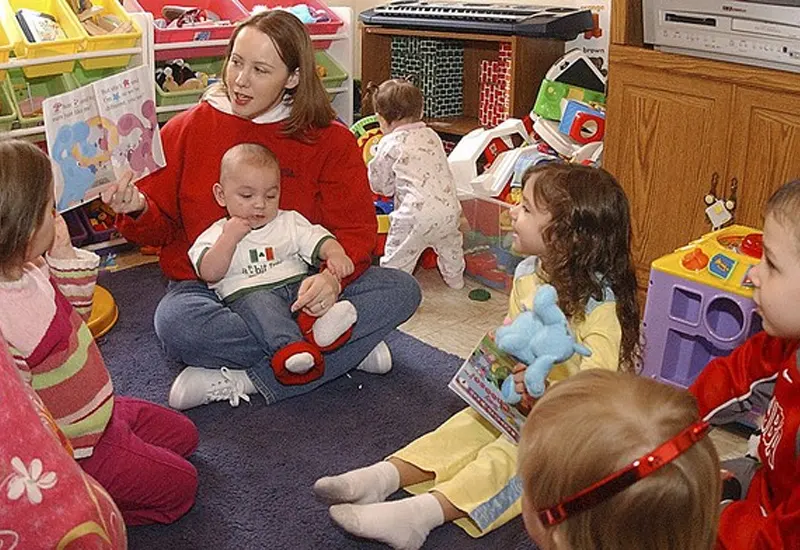
“Story Stretchers” are short, interactive follow-ups to a read-aloud session that extend comprehension and bring the story to life. After reading a picture book during circle time, the group engages in a related song, movement activity, role-play, or discussion. These extensions help children deepen their understanding, connect personally with the story, and build narrative skills through multisensory engagement.
必要な材料
- A selected picture book
- Related props, puppets, or song (optional)
Step‑by‑Step Instructions
- Read a story aloud during circle time, pausing for questions and discussion.
- After reading, introduce a simple follow-up activity related to the book’s theme or characters.
- Examples: Act out a scene, sing a song the character might sing, or retell the story using puppets.
- Invite children to share their favorite part or what they would do if they were in the story.
- Wrap up by connecting the story to real life (“Have you ever felt like that character?”).
Learning Objectives:
This activity supports early literacy by reinforcing story structure, character understanding, and sequencing through creative extension. It promotes oral language development and imaginative thinking as children retell or dramatize elements from the book. Emotional connections are strengthened through reflection, and comprehension is deepened through discussion and multisensory involvement. It also helps develop listening stamina and builds a love for storytelling.
21. Classroom Compliment Chain
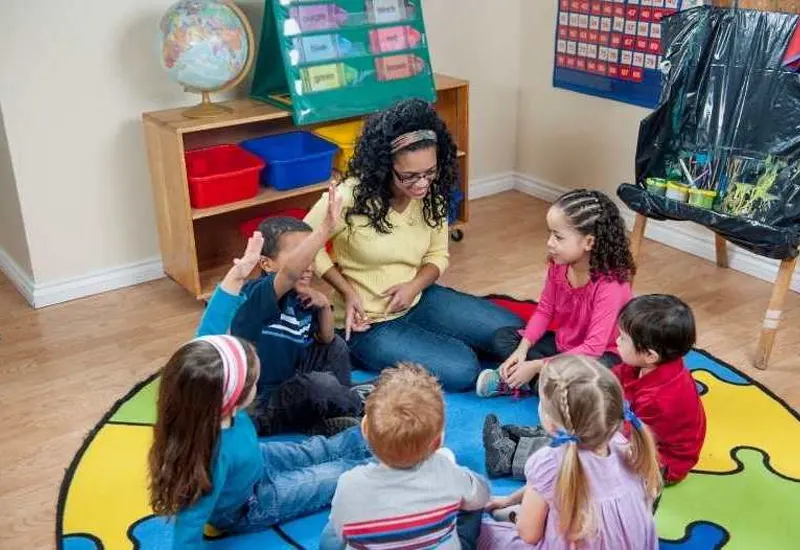
The Compliment Chain is a kindness-centered activity that helps children give and receive positive affirmations in a safe, structured way. One child begins by complimenting a peer (e.g., “I like how you helped clean up”), and that peer passes a new compliment to another child. It continues until every child is included.
必要な材料
- None
Step‑by‑Step Instructions
- Explain the idea of giving compliments and why they’re important.
- Start with one child giving a genuine compliment to someone else in the circle.
- The receiver then gives a new compliment to another child.
- Continue until everyone has both given and received a compliment.
- Reflect with the group on how it felt.
Learning Objectives
Children develop self-esteem and social bonding through positive reinforcement. They learn to recognize kind behavior and express appreciation. This activity builds emotional intelligence, speaking confidence, and group unity. In the context of circle time activities, it lays a foundation for a respectful and supportive classroom environment.
22. Memory Match Circle
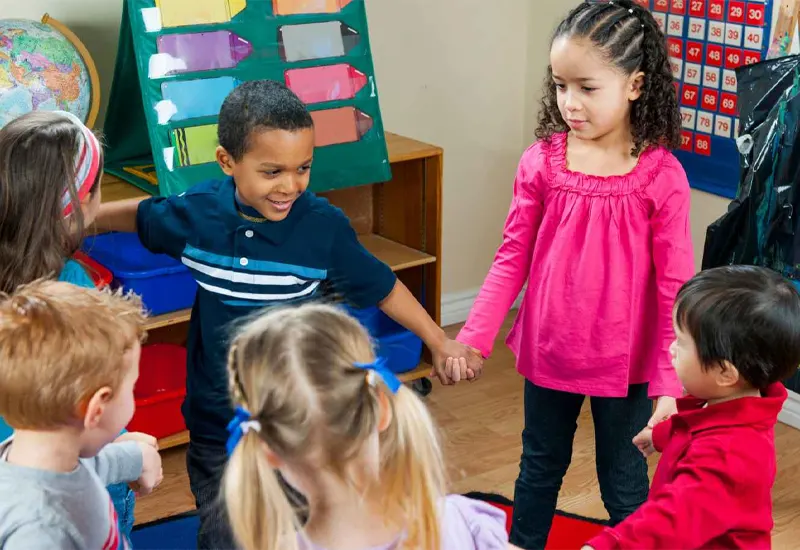
Memory Match Circle is a simplified, movement-based memory game played without cards. The teacher calls out a word or sound, and children match it with an agreed-upon movement (e.g., clap for “apple,” tap knees for “banana”). This dynamic circle time activity improves auditory memory, listening skills, and cognitive recall through physical engagement.
必要な材料
- A short list of 3–5 pairs of words and movements (can be theme-based)
- Enough space for gentle motion in the circle
Step‑by‑Step Instructions
- Introduce each word-movement pair and practice them as a group.
- Call out the words in random order, prompting the matching action.
- Increase speed as children become more confident.
- Add new words or switch the actions for a challenge.
- Conclude with a round of silent gestures and word recall.
Learning Objectives
This activity supports memory sequencing, auditory processing, and movement coordination. Children learn to associate abstract information with motor patterns, reinforcing recall. It also promotes self-control and group synchronization. Integrated into circle time activities, it balances brain and body engagement while sharpening attention.
23. Simon Says
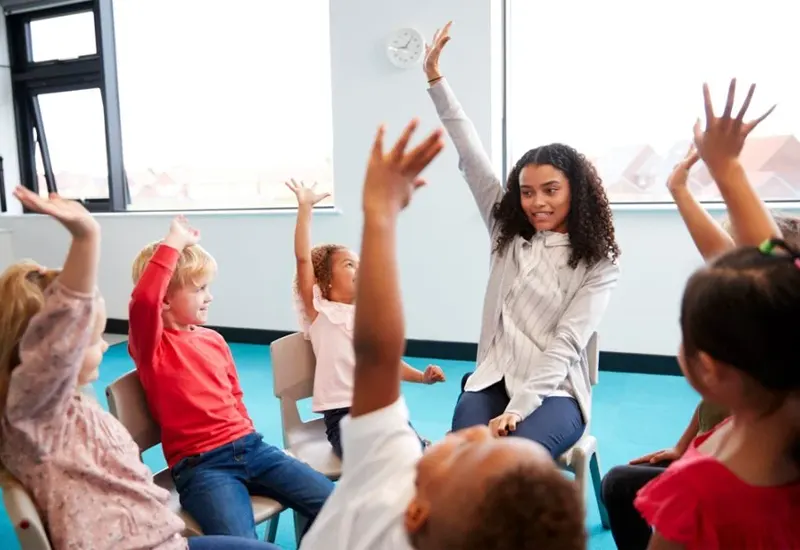
Simon Says is a highly engaging listening and movement activity that teaches children to follow instructions carefully while practicing self-control. During this circle time activity, the teacher gives action commands prefaced by “Simon says…”—only those commands should be followed. Children must resist the impulse to act if a command is given without the phrase. This builds focus, auditory processing, and decision-making in a fun and non-competitive environment.
必要な材料
- None
Step‑by‑Step Instructions
- Explain the rules: act only when the command begins with “Simon says.”
- Begin with simple actions: “Simon says touch your toes,” “Simon says jump.”
- Occasionally drop the phrase and observe who acts mistakenly.
- Keep the tone encouraging, not punitive—help children learn from mistakes.
- Rotate command types and adjust pace to challenge listening skills.
Learning Objectives
Children improve auditory discrimination and self-regulation by distinguishing between action cues. They develop gross motor skills through varied physical responses. The game reinforces rule-following and builds attention span. As a classic circle time activity, Simon Says supports cognitive control and whole-group engagement.
24. Circle Time Song and Movement Game

Using music and movement during circle time is a powerful way to boost children’s engagement and support multiple areas of development. In this activity, children sing a repetitive song while incorporating physical actions. This promotes rhythm, listening, gross motor coordination, and group participation. The structured routine provides a joyful, multisensory experience that energizes the class and builds community.
必要な材料
- A simple repetitive children’s song (e.g., “If You’re Happy and You Know It”)
- Open space for movement
- Optional: visual cards with action cues (e.g., clapping, stomping, spinning)
Step-by-Step Instructions
- Choose a song with simple lyrics and repetitive movements.
- Explain the lyrics and model each movement slowly before starting.
- Begin singing as a group, encouraging everyone to perform the actions together.
- Gradually increase the pace or introduce variations (e.g., different body parts, emotions).
- End with a calming version or a transition cue into the next part of the day.
Learning Objectives
This activity supports gross motor development and rhythm awareness while reinforcing listening skills and following directions. It promotes social interaction through shared movement and boosts memory through repetition. The combination of music and action helps children process language more effectively and builds classroom unity through shared joy and laughter.
25. Head, Shoulders, Knees, and Toes

“Head, Shoulders, Knees, and Toes” is a beloved circle time song that combines music, movement, and vocabulary learning. Children sing along while touching the corresponding body parts, developing gross motor coordination, body awareness, and rhythm. The song’s repetitive nature makes it ideal for language acquisition and memory-building.
必要な材料
- A music player or teacher-led version of the song “Head, Shoulders, Knees, and Toes”
- Open space for children to move freely
Step-by-Step Instructions
- Begin by reviewing each body part in the song using gestures and visual aids.
- Sing the song slowly the first time, modeling the motions for “head, shoulders, knees, and toes.”
- Encourage children to join in by singing and touching each body part along with the lyrics.
- Repeat the song several times, increasing the speed or adding fun variations (e.g., whispering, clapping instead of touching, or singing in silly voices).
- End with a slow version to help children calm down and transition to the next activity.
Learning Objectives
This activity supports body awareness, listening skills, and gross motor development. It reinforces vocabulary related to body parts and encourages imitation and rhythm synchronization. Repetition and participation help with memory and confidence, while singing and movement provide a joyful, multisensory learning experience.
26. Pass the Ball

“Pass the Ball” is a flexible and interactive circle-time game that encourages turn-taking, active listening, and verbal expression. Children sit in a circle and pass a ball while music plays or as part of a question-and-answer game. This activity builds community, strengthens motor skills, and fosters language development in a playful, low-pressure setting.
必要な材料
- A soft ball or plush toy that’s easy to grip and pass
- Background music
- Optional: list of themed questions or prompts (e.g., favorite color, animal, weather)
Step-by-Step Instructions
- Have all children sit in a circle.
- Explain the rules: the ball will be passed around while music plays or while you count aloud.
- Start passing the ball clockwise.
- When the music stops or counting ends, the child holding the ball answers a question or shares something (e.g., “What’s your favorite fruit?”).
- You can vary the game by using themed days: emotion-sharing, vocabulary recall, or storytelling starters.
- Continue until each child has had a turn or interest begins to fade.
Learning Objectives
“Pass the Ball” develops turn-taking, listening, and expressive language skills. It promotes group participation and helps shy children find a voice in a supportive setting. The passing motion also reinforces fine and gross motor control, while the unpredictable nature of the game keeps children engaged and attentive.
27. Musical Chairs

“Musical Chairs” is a high-energy circle time game that combines movement, music, and anticipation. As children walk around chairs while music plays, they must quickly find a seat when the music stops. This game builds focus, coordination, and emotional regulation—all wrapped in fun and laughter.
必要な材料
- Small chairs (one fewer than the number of children)
- Music player or teacher-led singing/clapping
- Open space for movement and safe walking
Step-by-Step Instruction
- Arrange chairs in a circle, seat-side out, with one fewer chair than the number of players.
- Have children walk around the chairs in one direction as the music plays.
- Stop the music suddenly. Each child tries to sit on a chair.
- The child left standing helps control the music for the next round or becomes a cheerleader.
- Remove one more chair and repeat the game.
- Continue until two children compete for the final chair.
Learning Objectives
Musical Chairs strengthens auditory processing, focus, and motor coordination. They also teach children to manage frustration, take turns, and react quickly. When adapted for inclusivity, they also promote empathy, cooperation, and resilience in a group setting.
28. Gentle Yoga

“Gentle Yoga” is a calming circle time activity designed to help preschoolers stretch their bodies, regulate their breathing, and build mindfulness. Through simple poses and guided movements, children learn how to slow down, connect with their bodies, and manage emotions peacefully and playfully.
必要な材料
- Soft floor space or individual mats (optional)
- Calm background music (optional)
- Visual cards or teacher demonstration of simple yoga poses (e.g., butterfly, tree, cat-cow)
Step-by-Step Instructions
- Invite children to find their personal space and sit criss-cross with hands on their knees.
- Begin with 2–3 deep breaths, guiding children to breathe in through their nose and out through their mouth.
- Introduce 3–4 basic yoga poses, modeling each one slowly:
- Butterfly Pose (soles of feet together, knees out, flap gently)
- Tree Pose (one foot on ankle or calf, arms up like branches)
- Cat-Cow Pose (on hands and knees, arch and dip back gently)
- Child’s Pose (kneel and stretch arms forward on the floor)
- Hold each pose for a few seconds while encouraging calm breathing.
- End with a short guided “resting pose” or calming mantra (e.g., “I am calm, I am strong”).
Learning Objectives
Gentle Yoga fosters self-awareness, balance, and body control. It teaches children calming strategies that support emotional regulation and stress management. This activity also improves focus, flexibility, and spatial awareness while building a peaceful, respectful classroom atmosphere.
29. Taking Turns with a Talking Stick

“Talking Stick” is a powerful Circle Time activity that promotes respectful communication, active listening, and turn-taking. Children pass a special object around the circle and learn that only the person holding the stick has the floor to speak. This structured format helps create a safe, inclusive environment where every voice is heard.
必要な材料
- A designated “talking stick” (can be a decorated stick, baton, or plush microphone)
- A list of simple discussion prompts (e.g., “What made you smile today?” “What do you like about your friend?”)
- Optional: calming music or a quiet bell to begin and end the sharing
Step-by-Step Instructions
- Introduce the talking stick and explain the rule: only the person holding it may speak, while others listen quietly.
- Begin with a simple question or prompt for children to respond to.
- Pass the stick around the circle. Each child can choose to speak or simply pass the stick along.
- Reinforce respectful listening, eye contact, and quiet bodies while others speak.
- After each round, praise the group for taking turns and being thoughtful listeners.
- You can vary the prompts daily or connect them to classroom themes (feelings, seasons, family, etc.).
Learning Objectives
This activity builds oral language skills, confidence, and self-expression. It teaches children the value of listening without interrupting and helps them feel respected and included. The talking stick fosters community, patience, and mindfulness—essential lifelong communication and emotional intelligence skills.
30. Group Hug

“Group Hug” is a gentle and emotionally enriching Circle Time activity that strengthens bonds between classmates and fosters a sense of belonging. In this activity, children join together in a group hug or supportive gesture at the end (or beginning) of circle time, creating a shared moment of comfort, connection, and kindness.
必要な材料
- A clear, safe space in the center of the circle
- Optional: a soft song or chime to signal the start or end of the group hug
- Optional: a group mascot (e.g., class teddy bear) to hold during the hug
Step-by-Step Instructions
- Invite children to gather in the center or stand in a close circle, reminding them to be gentle and respectful with personal space.
- Announce the “Group Hug” moment: it can be a full hug, a group cheer, or everyone gently placing hands on shoulders or backs.
- Encourage children to say something kind as they hug (e.g., “I’m glad you’re here” or “We’re a great team”).
- After a few seconds, gently guide everyone back to their spots with a deep breath or calming gesture.
- This activity can be used to close the circle time with a feeling of unity and safety.
Learning Objectives
Group Hug promotes emotional connection, empathy, and classroom community. It helps children feel seen, valued, and supported, which boosts emotional security and trust. This activity also reinforces social-emotional vocabulary and appropriate physical boundaries, making it a powerful yet simple tool for nurturing relationships.
結論
From movement games that support physical development to quiet thinking challenges that sharpen memory and empathy, these activities offer diverse ways to meet children where they are—and bring them forward together. Whether you’re starting your day with a mindful breath, passing a rhythm around the circle, or helping children recognize and name their feelings, every small moment during circle time contributes to a much larger developmental journey.
As you plan your daily routines, remember that the most effective circle time activities are those that adapt to your unique group of learners—celebrating their personalities, meeting their needs, and inspiring them to participate with joy and purpose. With consistency, creativity, and care, circle time becomes more than a schedule slot—it becomes a sanctuary of connection and growth.

